Taxation Law Case Study: Determination of Partnership Net Income, Expenses, and Deductions
VerifiedAdded on 2023/04/25
|13
|2530
|341
AI Summary
The case study in taxation law involves the determination of net income for a partnership. The partnership is not a separate legal entity and partners are taxed on profit distribution. Receipts derived from ordinary business activities are considered normal business proceeds. Deductions are allowed for expenses related to producing taxable income. Private expenses and capital expenditures are not deductible. Repairs and maintenance expenses are deductible, as well as immediate deductions for depreciating business assets under $20,000. The computation of partnership net income includes receipts and eligible expenses. The net income for the partnership is $2,373.
Contribute Materials
Your contribution can guide someone’s learning journey. Share your
documents today.
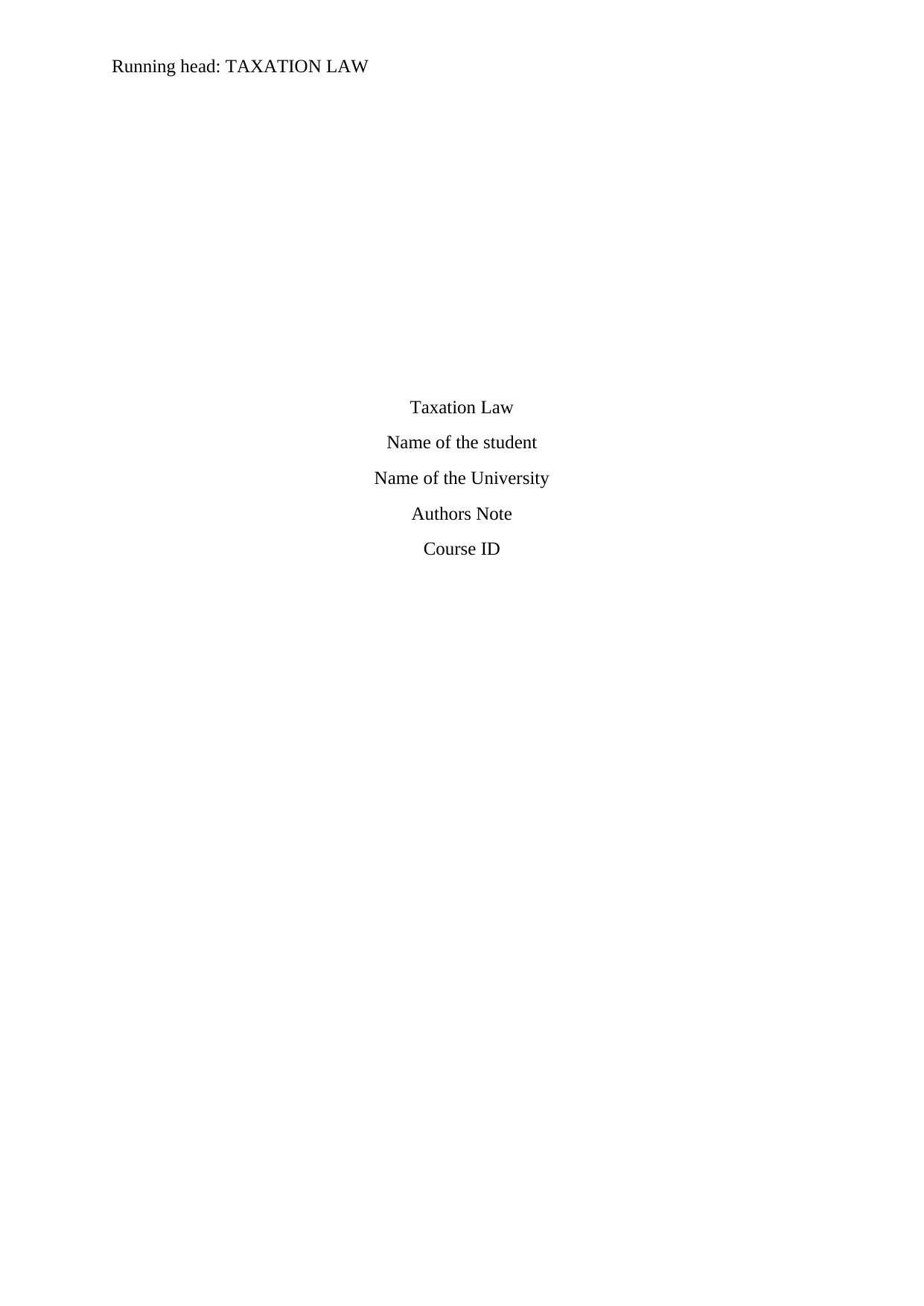
Running head: TAXATION LAW
Taxation Law
Name of the student
Name of the University
Authors Note
Course ID
Taxation Law
Name of the student
Name of the University
Authors Note
Course ID
Secure Best Marks with AI Grader
Need help grading? Try our AI Grader for instant feedback on your assignments.
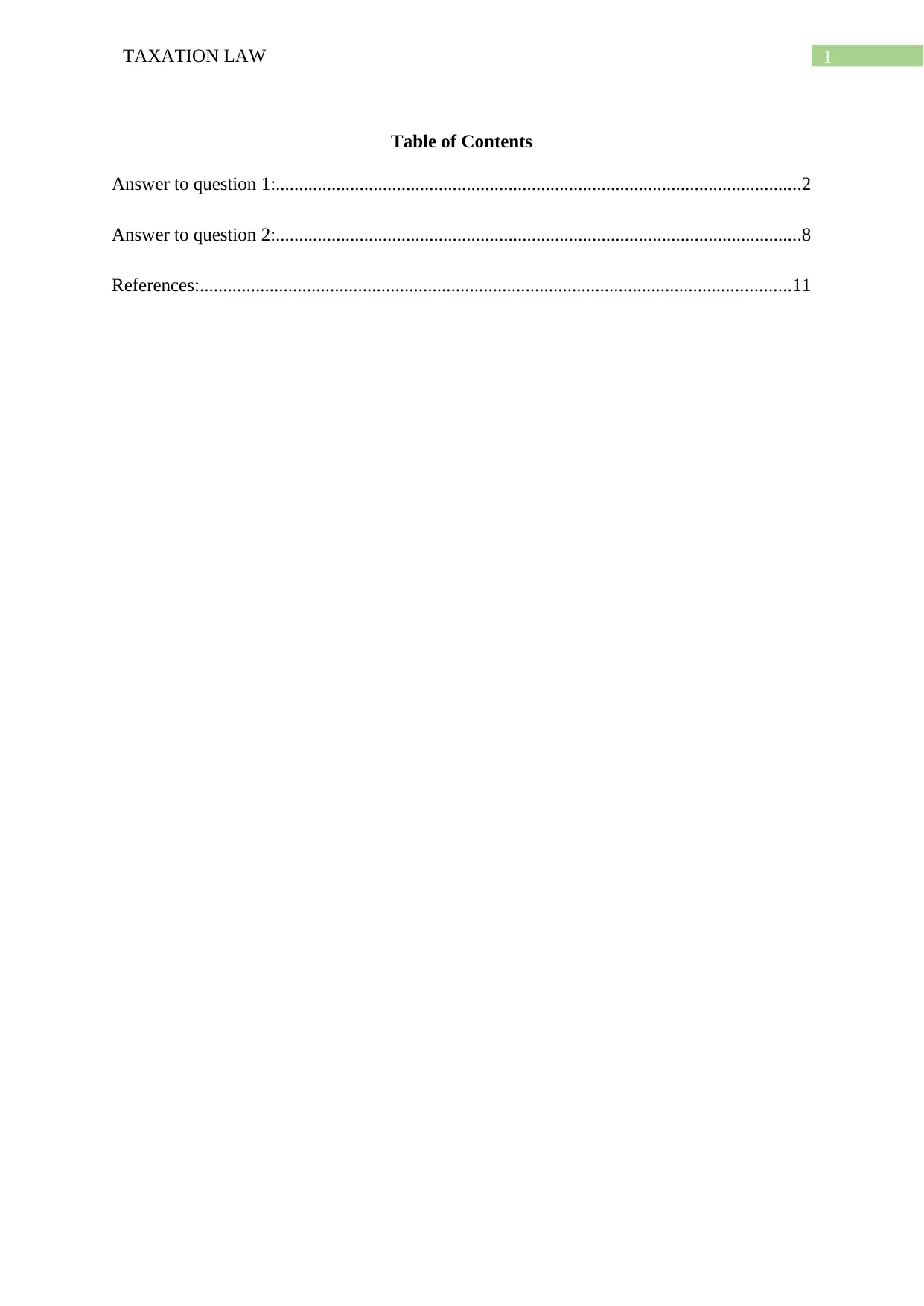
1TAXATION LAW
Table of Contents
Answer to question 1:.................................................................................................................2
Answer to question 2:.................................................................................................................8
References:...............................................................................................................................11
Table of Contents
Answer to question 1:.................................................................................................................2
Answer to question 2:.................................................................................................................8
References:...............................................................................................................................11
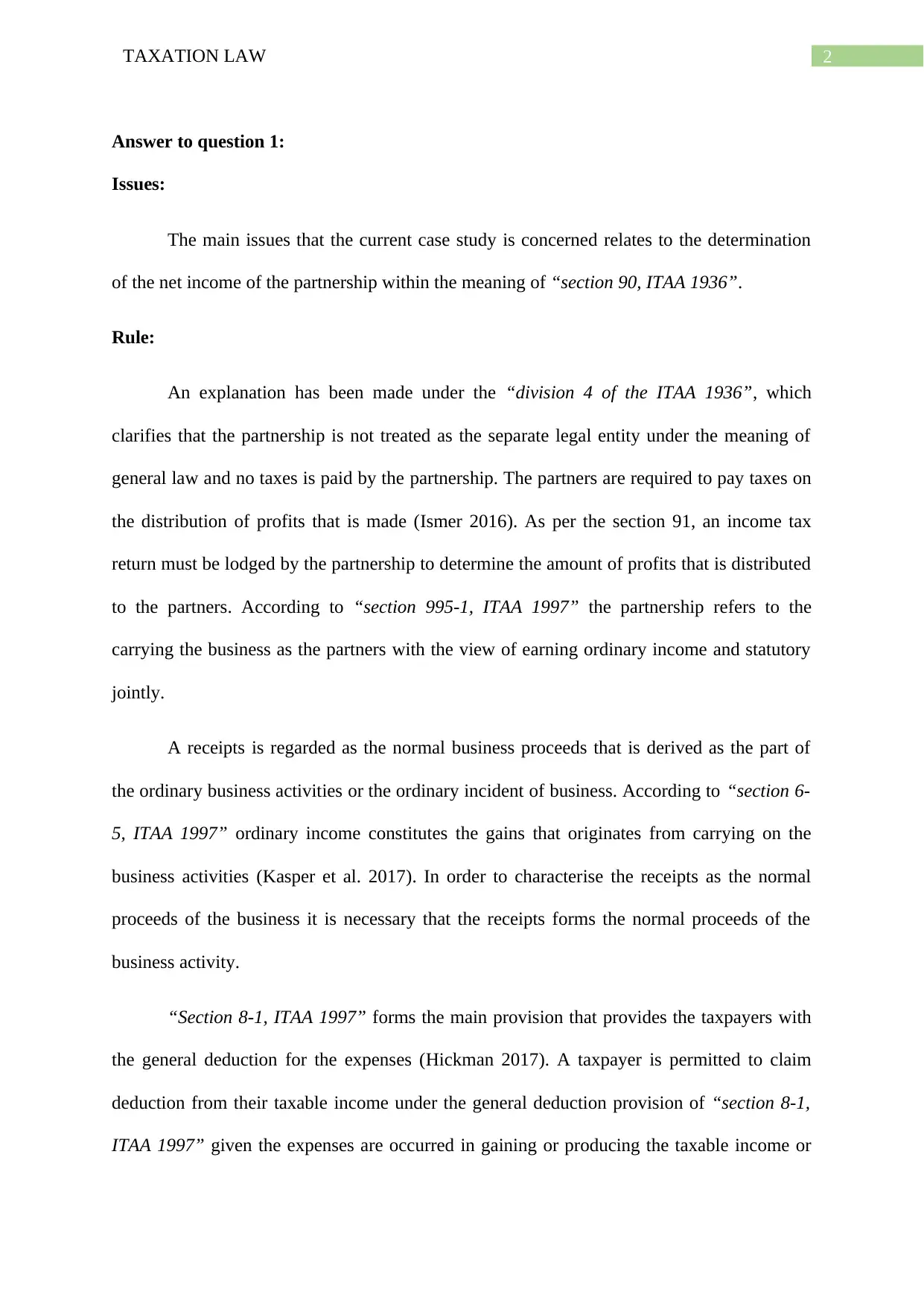
2TAXATION LAW
Answer to question 1:
Issues:
The main issues that the current case study is concerned relates to the determination
of the net income of the partnership within the meaning of “section 90, ITAA 1936”.
Rule:
An explanation has been made under the “division 4 of the ITAA 1936”, which
clarifies that the partnership is not treated as the separate legal entity under the meaning of
general law and no taxes is paid by the partnership. The partners are required to pay taxes on
the distribution of profits that is made (Ismer 2016). As per the section 91, an income tax
return must be lodged by the partnership to determine the amount of profits that is distributed
to the partners. According to “section 995-1, ITAA 1997” the partnership refers to the
carrying the business as the partners with the view of earning ordinary income and statutory
jointly.
A receipts is regarded as the normal business proceeds that is derived as the part of
the ordinary business activities or the ordinary incident of business. According to “section 6-
5, ITAA 1997” ordinary income constitutes the gains that originates from carrying on the
business activities (Kasper et al. 2017). In order to characterise the receipts as the normal
proceeds of the business it is necessary that the receipts forms the normal proceeds of the
business activity.
“Section 8-1, ITAA 1997” forms the main provision that provides the taxpayers with
the general deduction for the expenses (Hickman 2017). A taxpayer is permitted to claim
deduction from their taxable income under the general deduction provision of “section 8-1,
ITAA 1997” given the expenses are occurred in gaining or producing the taxable income or
Answer to question 1:
Issues:
The main issues that the current case study is concerned relates to the determination
of the net income of the partnership within the meaning of “section 90, ITAA 1936”.
Rule:
An explanation has been made under the “division 4 of the ITAA 1936”, which
clarifies that the partnership is not treated as the separate legal entity under the meaning of
general law and no taxes is paid by the partnership. The partners are required to pay taxes on
the distribution of profits that is made (Ismer 2016). As per the section 91, an income tax
return must be lodged by the partnership to determine the amount of profits that is distributed
to the partners. According to “section 995-1, ITAA 1997” the partnership refers to the
carrying the business as the partners with the view of earning ordinary income and statutory
jointly.
A receipts is regarded as the normal business proceeds that is derived as the part of
the ordinary business activities or the ordinary incident of business. According to “section 6-
5, ITAA 1997” ordinary income constitutes the gains that originates from carrying on the
business activities (Kasper et al. 2017). In order to characterise the receipts as the normal
proceeds of the business it is necessary that the receipts forms the normal proceeds of the
business activity.
“Section 8-1, ITAA 1997” forms the main provision that provides the taxpayers with
the general deduction for the expenses (Hickman 2017). A taxpayer is permitted to claim
deduction from their taxable income under the general deduction provision of “section 8-1,
ITAA 1997” given the expenses are occurred in gaining or producing the taxable income or
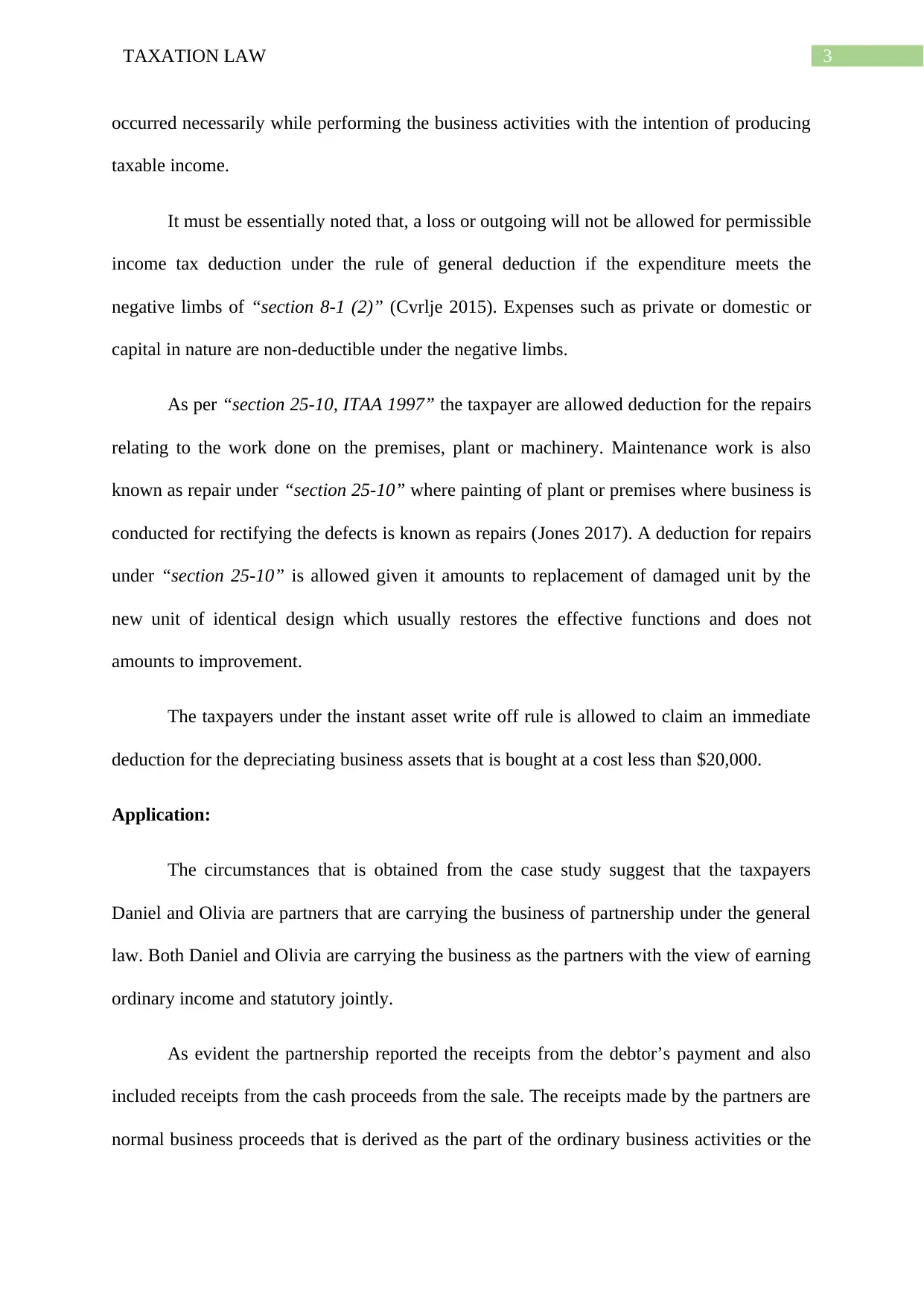
3TAXATION LAW
occurred necessarily while performing the business activities with the intention of producing
taxable income.
It must be essentially noted that, a loss or outgoing will not be allowed for permissible
income tax deduction under the rule of general deduction if the expenditure meets the
negative limbs of “section 8-1 (2)” (Cvrlje 2015). Expenses such as private or domestic or
capital in nature are non-deductible under the negative limbs.
As per “section 25-10, ITAA 1997” the taxpayer are allowed deduction for the repairs
relating to the work done on the premises, plant or machinery. Maintenance work is also
known as repair under “section 25-10” where painting of plant or premises where business is
conducted for rectifying the defects is known as repairs (Jones 2017). A deduction for repairs
under “section 25-10” is allowed given it amounts to replacement of damaged unit by the
new unit of identical design which usually restores the effective functions and does not
amounts to improvement.
The taxpayers under the instant asset write off rule is allowed to claim an immediate
deduction for the depreciating business assets that is bought at a cost less than $20,000.
Application:
The circumstances that is obtained from the case study suggest that the taxpayers
Daniel and Olivia are partners that are carrying the business of partnership under the general
law. Both Daniel and Olivia are carrying the business as the partners with the view of earning
ordinary income and statutory jointly.
As evident the partnership reported the receipts from the debtor’s payment and also
included receipts from the cash proceeds from the sale. The receipts made by the partners are
normal business proceeds that is derived as the part of the ordinary business activities or the
occurred necessarily while performing the business activities with the intention of producing
taxable income.
It must be essentially noted that, a loss or outgoing will not be allowed for permissible
income tax deduction under the rule of general deduction if the expenditure meets the
negative limbs of “section 8-1 (2)” (Cvrlje 2015). Expenses such as private or domestic or
capital in nature are non-deductible under the negative limbs.
As per “section 25-10, ITAA 1997” the taxpayer are allowed deduction for the repairs
relating to the work done on the premises, plant or machinery. Maintenance work is also
known as repair under “section 25-10” where painting of plant or premises where business is
conducted for rectifying the defects is known as repairs (Jones 2017). A deduction for repairs
under “section 25-10” is allowed given it amounts to replacement of damaged unit by the
new unit of identical design which usually restores the effective functions and does not
amounts to improvement.
The taxpayers under the instant asset write off rule is allowed to claim an immediate
deduction for the depreciating business assets that is bought at a cost less than $20,000.
Application:
The circumstances that is obtained from the case study suggest that the taxpayers
Daniel and Olivia are partners that are carrying the business of partnership under the general
law. Both Daniel and Olivia are carrying the business as the partners with the view of earning
ordinary income and statutory jointly.
As evident the partnership reported the receipts from the debtor’s payment and also
included receipts from the cash proceeds from the sale. The receipts made by the partners are
normal business proceeds that is derived as the part of the ordinary business activities or the
Secure Best Marks with AI Grader
Need help grading? Try our AI Grader for instant feedback on your assignments.
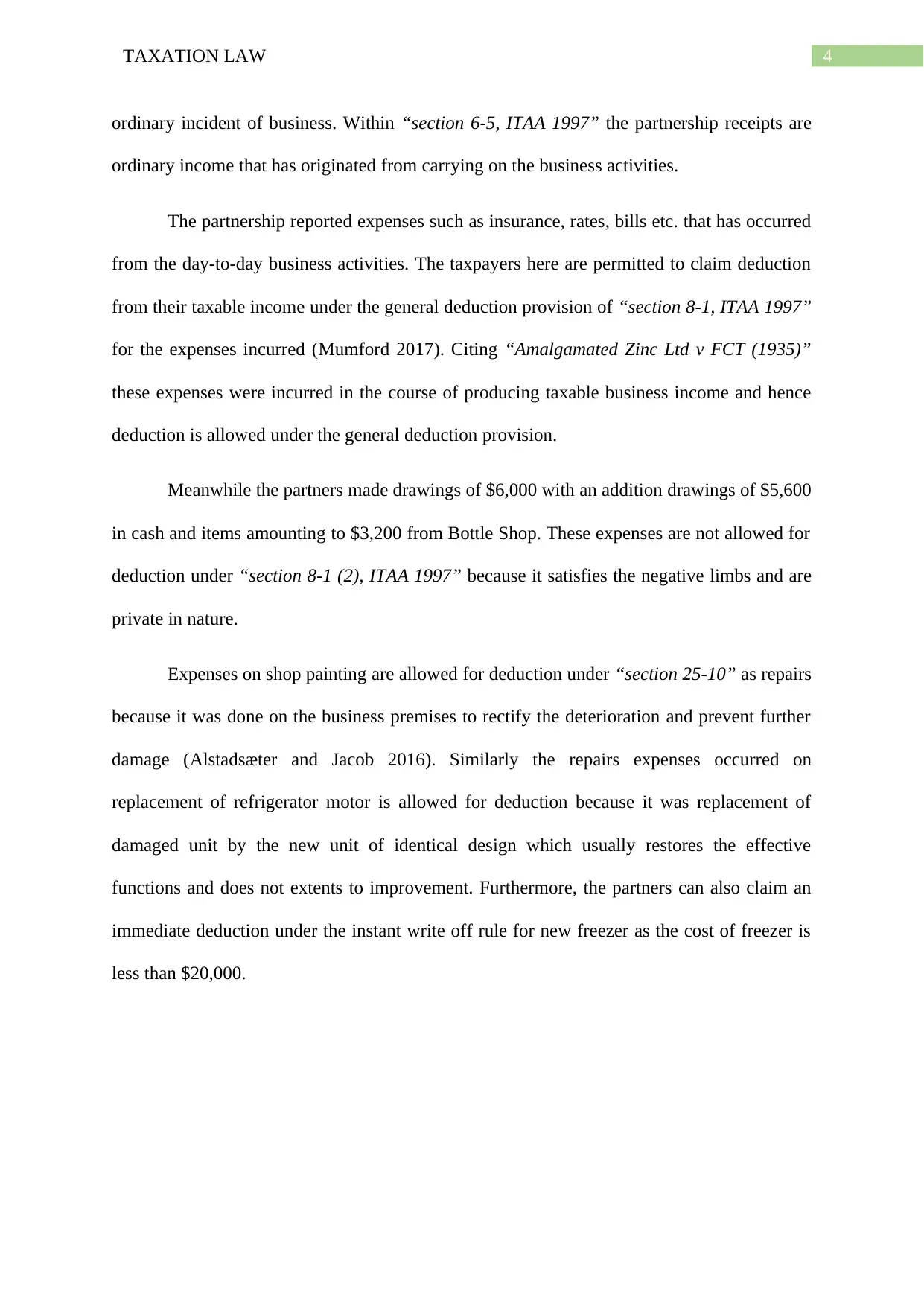
4TAXATION LAW
ordinary incident of business. Within “section 6-5, ITAA 1997” the partnership receipts are
ordinary income that has originated from carrying on the business activities.
The partnership reported expenses such as insurance, rates, bills etc. that has occurred
from the day-to-day business activities. The taxpayers here are permitted to claim deduction
from their taxable income under the general deduction provision of “section 8-1, ITAA 1997”
for the expenses incurred (Mumford 2017). Citing “Amalgamated Zinc Ltd v FCT (1935)”
these expenses were incurred in the course of producing taxable business income and hence
deduction is allowed under the general deduction provision.
Meanwhile the partners made drawings of $6,000 with an addition drawings of $5,600
in cash and items amounting to $3,200 from Bottle Shop. These expenses are not allowed for
deduction under “section 8-1 (2), ITAA 1997” because it satisfies the negative limbs and are
private in nature.
Expenses on shop painting are allowed for deduction under “section 25-10” as repairs
because it was done on the business premises to rectify the deterioration and prevent further
damage (Alstadsæter and Jacob 2016). Similarly the repairs expenses occurred on
replacement of refrigerator motor is allowed for deduction because it was replacement of
damaged unit by the new unit of identical design which usually restores the effective
functions and does not extents to improvement. Furthermore, the partners can also claim an
immediate deduction under the instant write off rule for new freezer as the cost of freezer is
less than $20,000.
ordinary incident of business. Within “section 6-5, ITAA 1997” the partnership receipts are
ordinary income that has originated from carrying on the business activities.
The partnership reported expenses such as insurance, rates, bills etc. that has occurred
from the day-to-day business activities. The taxpayers here are permitted to claim deduction
from their taxable income under the general deduction provision of “section 8-1, ITAA 1997”
for the expenses incurred (Mumford 2017). Citing “Amalgamated Zinc Ltd v FCT (1935)”
these expenses were incurred in the course of producing taxable business income and hence
deduction is allowed under the general deduction provision.
Meanwhile the partners made drawings of $6,000 with an addition drawings of $5,600
in cash and items amounting to $3,200 from Bottle Shop. These expenses are not allowed for
deduction under “section 8-1 (2), ITAA 1997” because it satisfies the negative limbs and are
private in nature.
Expenses on shop painting are allowed for deduction under “section 25-10” as repairs
because it was done on the business premises to rectify the deterioration and prevent further
damage (Alstadsæter and Jacob 2016). Similarly the repairs expenses occurred on
replacement of refrigerator motor is allowed for deduction because it was replacement of
damaged unit by the new unit of identical design which usually restores the effective
functions and does not extents to improvement. Furthermore, the partners can also claim an
immediate deduction under the instant write off rule for new freezer as the cost of freezer is
less than $20,000.
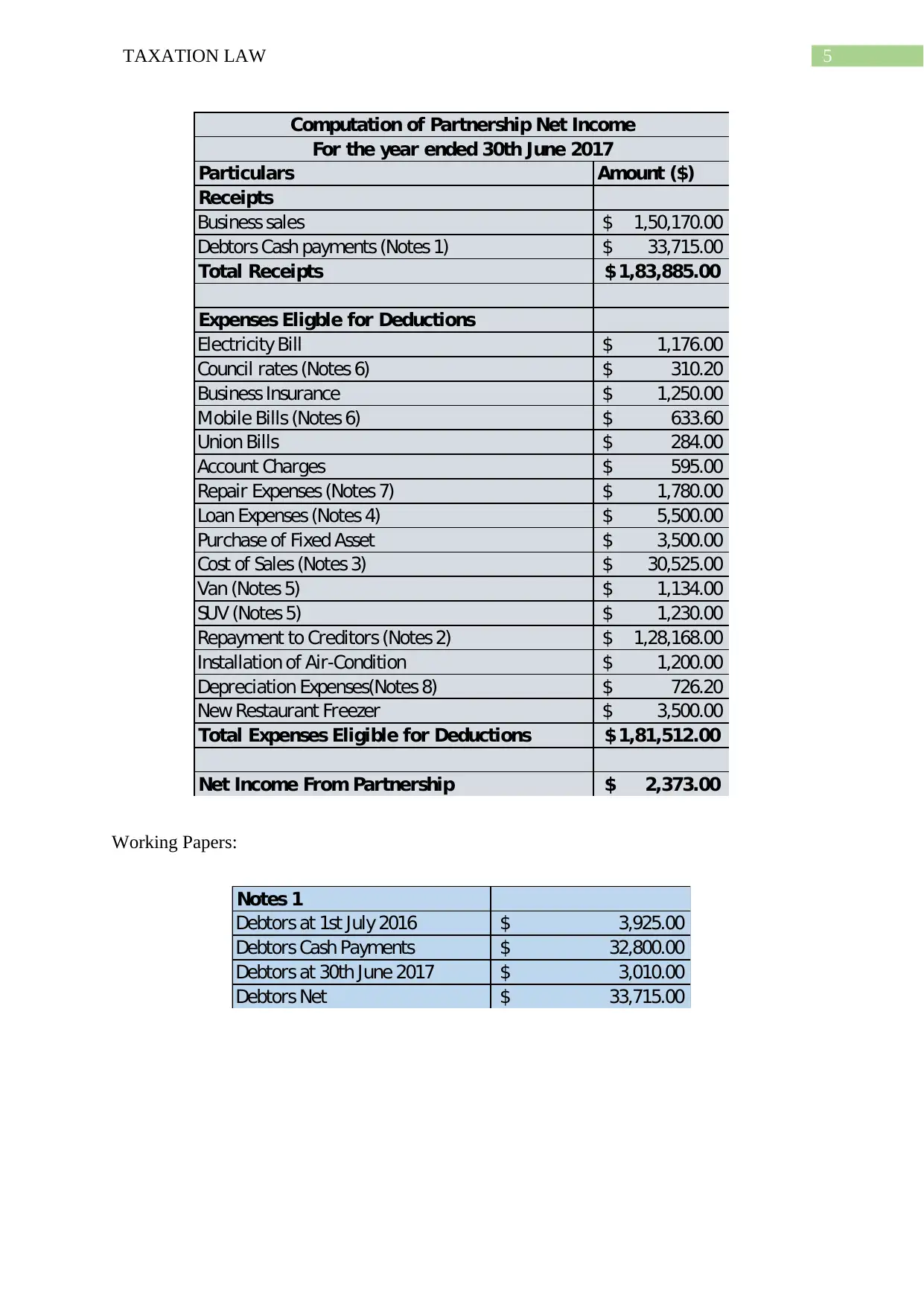
5TAXATION LAW
Particulars Amount ($)
Receipts
Business sales 1,50,170.00$
Debtors Cash payments (Notes 1) 33,715.00$
Total Receipts 1,83,885.00$
Expenses Eligble for Deductions
Electricity Bill 1,176.00$
Council rates (Notes 6) 310.20$
Business Insurance 1,250.00$
Mobile Bills (Notes 6) 633.60$
Union Bills 284.00$
Account Charges 595.00$
Repair Expenses (Notes 7) 1,780.00$
Loan Expenses (Notes 4) 5,500.00$
Purchase of Fixed Asset 3,500.00$
Cost of Sales (Notes 3) 30,525.00$
Van (Notes 5) 1,134.00$
SUV (Notes 5) 1,230.00$
Repayment to Creditors (Notes 2) 1,28,168.00$
Installation of Air-Condition 1,200.00$
Depreciation Expenses(Notes 8) 726.20$
New Restaurant Freezer 3,500.00$
Total Expenses Eligible for Deductions 1,81,512.00$
Net Income From Partnership 2,373.00$
Computation of Partnership Net Income
For the year ended 30th June 2017
Working Papers:
Notes 1
Debtors at 1st July 2016 3,925.00$
Debtors Cash Payments 32,800.00$
Debtors at 30th June 2017 3,010.00$
Debtors Net 33,715.00$
Particulars Amount ($)
Receipts
Business sales 1,50,170.00$
Debtors Cash payments (Notes 1) 33,715.00$
Total Receipts 1,83,885.00$
Expenses Eligble for Deductions
Electricity Bill 1,176.00$
Council rates (Notes 6) 310.20$
Business Insurance 1,250.00$
Mobile Bills (Notes 6) 633.60$
Union Bills 284.00$
Account Charges 595.00$
Repair Expenses (Notes 7) 1,780.00$
Loan Expenses (Notes 4) 5,500.00$
Purchase of Fixed Asset 3,500.00$
Cost of Sales (Notes 3) 30,525.00$
Van (Notes 5) 1,134.00$
SUV (Notes 5) 1,230.00$
Repayment to Creditors (Notes 2) 1,28,168.00$
Installation of Air-Condition 1,200.00$
Depreciation Expenses(Notes 8) 726.20$
New Restaurant Freezer 3,500.00$
Total Expenses Eligible for Deductions 1,81,512.00$
Net Income From Partnership 2,373.00$
Computation of Partnership Net Income
For the year ended 30th June 2017
Working Papers:
Notes 1
Debtors at 1st July 2016 3,925.00$
Debtors Cash Payments 32,800.00$
Debtors at 30th June 2017 3,010.00$
Debtors Net 33,715.00$
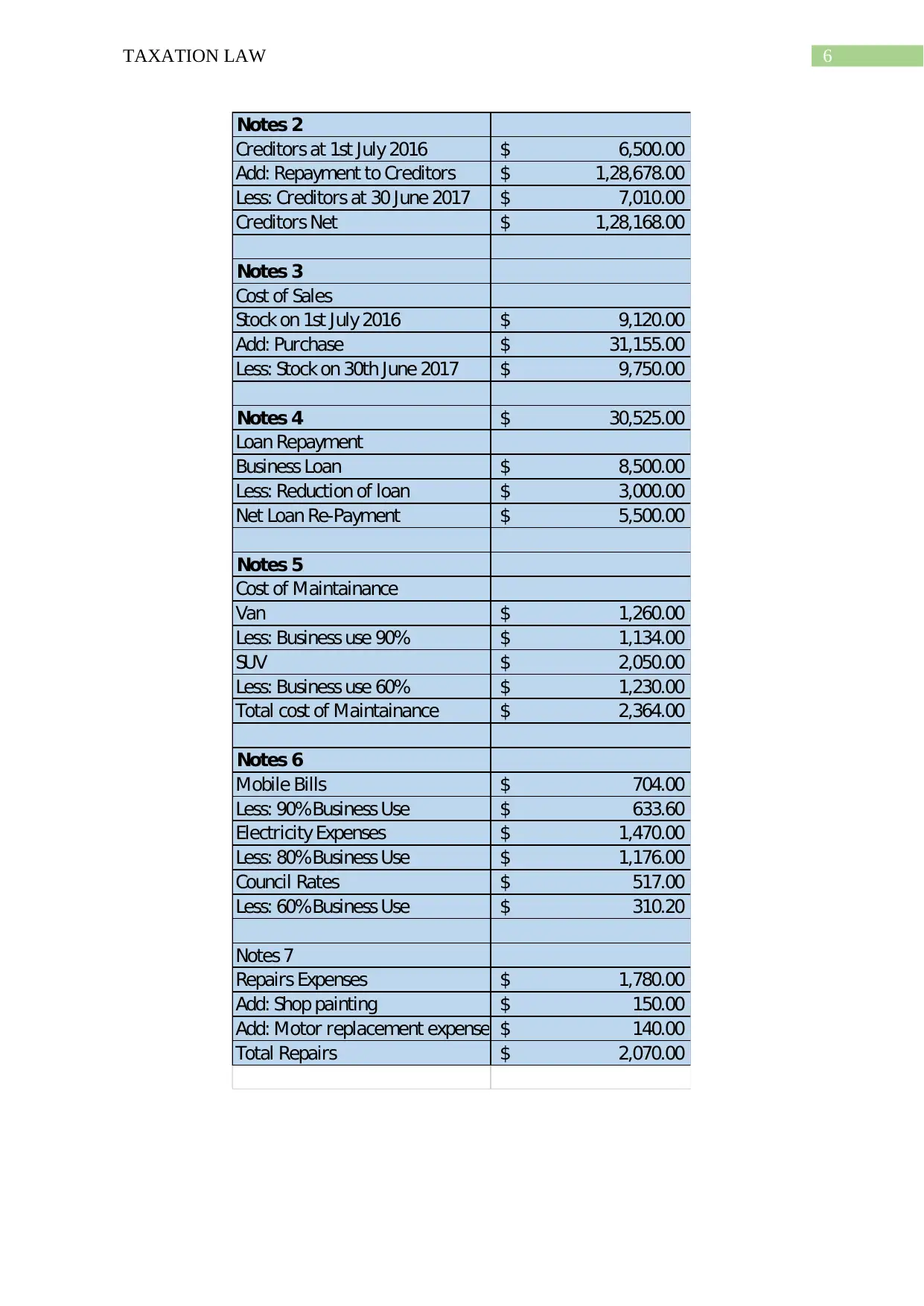
6TAXATION LAW
Notes 2
Creditors at 1st July 2016 6,500.00$
Add: Repayment to Creditors 1,28,678.00$
Less: Creditors at 30 June 2017 7,010.00$
Creditors Net 1,28,168.00$
Notes 3
Cost of Sales
Stock on 1st July 2016 9,120.00$
Add: Purchase 31,155.00$
Less: Stock on 30th June 2017 9,750.00$
Notes 4 30,525.00$
Loan Repayment
Business Loan 8,500.00$
Less: Reduction of loan 3,000.00$
Net Loan Re-Payment 5,500.00$
Notes 5
Cost of Maintainance
Van 1,260.00$
Less: Business use 90% 1,134.00$
SUV 2,050.00$
Less: Business use 60% 1,230.00$
Total cost of Maintainance 2,364.00$
Notes 6
Mobile Bills 704.00$
Less: 90%Business Use 633.60$
Electricity Expenses 1,470.00$
Less: 80%Business Use 1,176.00$
Council Rates 517.00$
Less: 60%Business Use 310.20$
Notes 7
Repairs Expenses 1,780.00$
Add: Shop painting 150.00$
Add: Motor replacement expenses 140.00$
Total Repairs 2,070.00$
Notes 2
Creditors at 1st July 2016 6,500.00$
Add: Repayment to Creditors 1,28,678.00$
Less: Creditors at 30 June 2017 7,010.00$
Creditors Net 1,28,168.00$
Notes 3
Cost of Sales
Stock on 1st July 2016 9,120.00$
Add: Purchase 31,155.00$
Less: Stock on 30th June 2017 9,750.00$
Notes 4 30,525.00$
Loan Repayment
Business Loan 8,500.00$
Less: Reduction of loan 3,000.00$
Net Loan Re-Payment 5,500.00$
Notes 5
Cost of Maintainance
Van 1,260.00$
Less: Business use 90% 1,134.00$
SUV 2,050.00$
Less: Business use 60% 1,230.00$
Total cost of Maintainance 2,364.00$
Notes 6
Mobile Bills 704.00$
Less: 90%Business Use 633.60$
Electricity Expenses 1,470.00$
Less: 80%Business Use 1,176.00$
Council Rates 517.00$
Less: 60%Business Use 310.20$
Notes 7
Repairs Expenses 1,780.00$
Add: Shop painting 150.00$
Add: Motor replacement expenses 140.00$
Total Repairs 2,070.00$
Paraphrase This Document
Need a fresh take? Get an instant paraphrase of this document with our AI Paraphraser
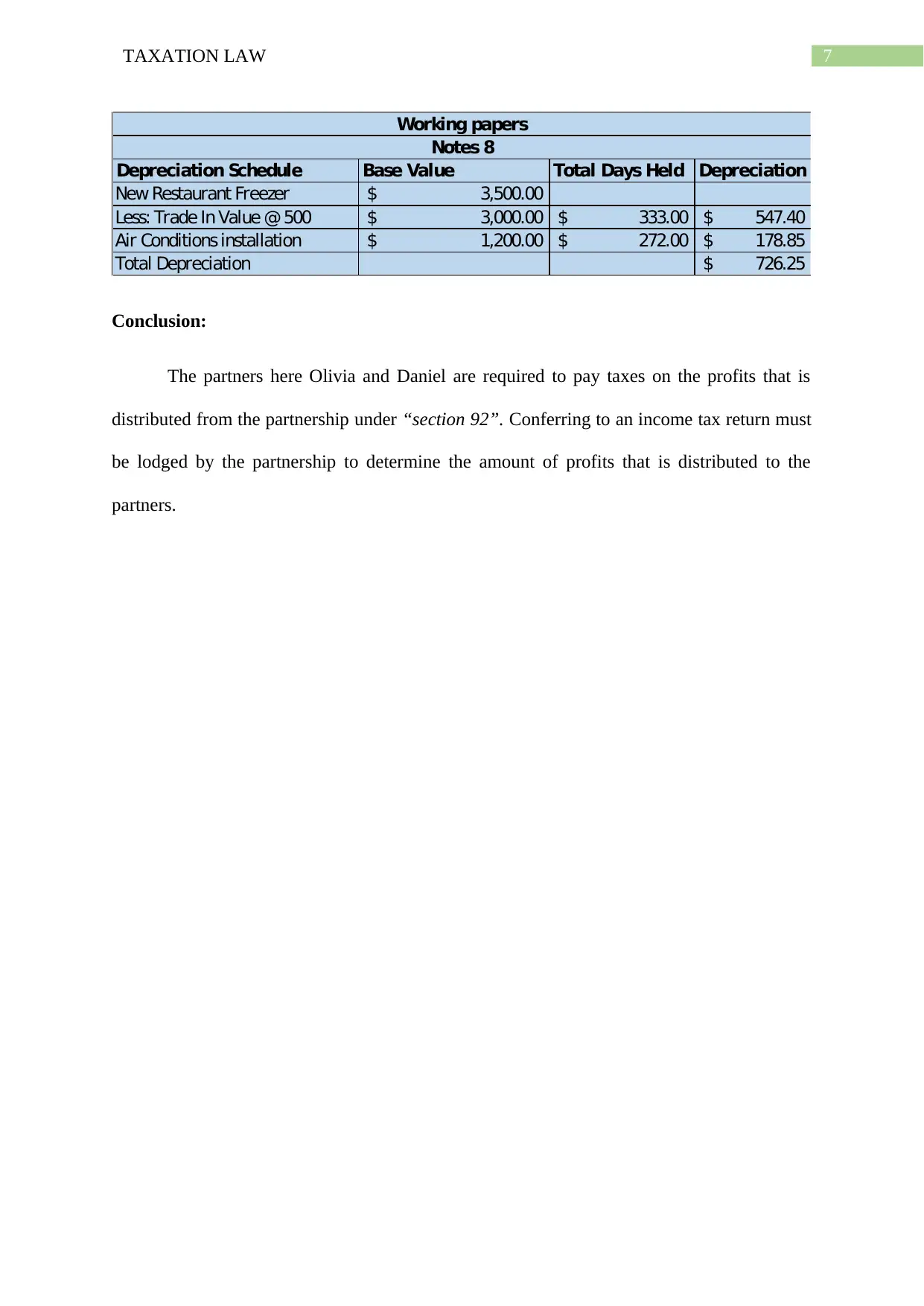
7TAXATION LAW
Depreciation Schedule Base Value Total Days Held Depreciation
New Restaurant Freezer 3,500.00$
Less: Trade In Value @ 500 3,000.00$ 333.00$ 547.40$
Air Conditions installation 1,200.00$ 272.00$ 178.85$
Total Depreciation 726.25$
Working papers
Notes 8
Conclusion:
The partners here Olivia and Daniel are required to pay taxes on the profits that is
distributed from the partnership under “section 92”. Conferring to an income tax return must
be lodged by the partnership to determine the amount of profits that is distributed to the
partners.
Depreciation Schedule Base Value Total Days Held Depreciation
New Restaurant Freezer 3,500.00$
Less: Trade In Value @ 500 3,000.00$ 333.00$ 547.40$
Air Conditions installation 1,200.00$ 272.00$ 178.85$
Total Depreciation 726.25$
Working papers
Notes 8
Conclusion:
The partners here Olivia and Daniel are required to pay taxes on the profits that is
distributed from the partnership under “section 92”. Conferring to an income tax return must
be lodged by the partnership to determine the amount of profits that is distributed to the
partners.
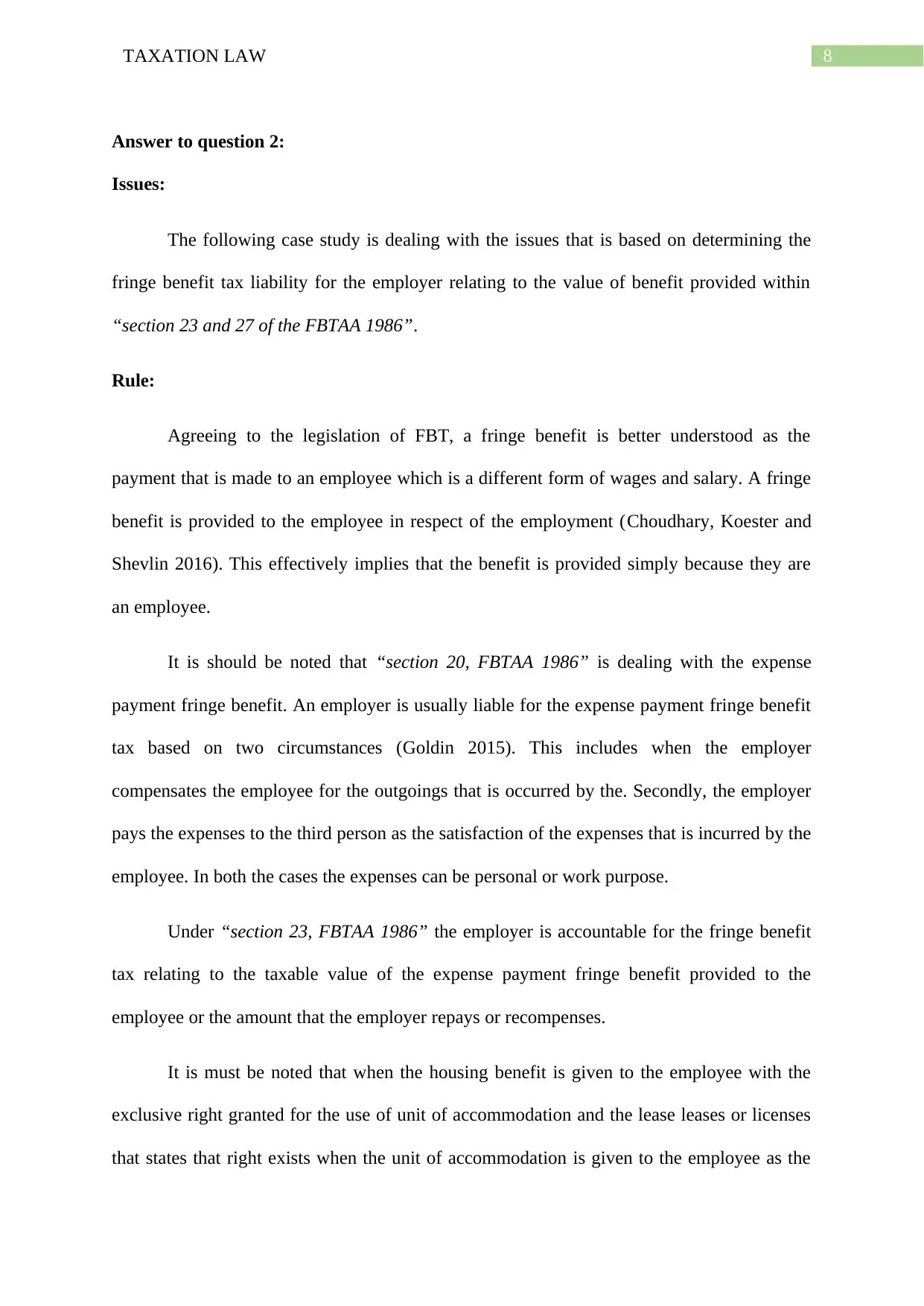
8TAXATION LAW
Answer to question 2:
Issues:
The following case study is dealing with the issues that is based on determining the
fringe benefit tax liability for the employer relating to the value of benefit provided within
“section 23 and 27 of the FBTAA 1986”.
Rule:
Agreeing to the legislation of FBT, a fringe benefit is better understood as the
payment that is made to an employee which is a different form of wages and salary. A fringe
benefit is provided to the employee in respect of the employment (Choudhary, Koester and
Shevlin 2016). This effectively implies that the benefit is provided simply because they are
an employee.
It is should be noted that “section 20, FBTAA 1986” is dealing with the expense
payment fringe benefit. An employer is usually liable for the expense payment fringe benefit
tax based on two circumstances (Goldin 2015). This includes when the employer
compensates the employee for the outgoings that is occurred by the. Secondly, the employer
pays the expenses to the third person as the satisfaction of the expenses that is incurred by the
employee. In both the cases the expenses can be personal or work purpose.
Under “section 23, FBTAA 1986” the employer is accountable for the fringe benefit
tax relating to the taxable value of the expense payment fringe benefit provided to the
employee or the amount that the employer repays or recompenses.
It is must be noted that when the housing benefit is given to the employee with the
exclusive right granted for the use of unit of accommodation and the lease leases or licenses
that states that right exists when the unit of accommodation is given to the employee as the
Answer to question 2:
Issues:
The following case study is dealing with the issues that is based on determining the
fringe benefit tax liability for the employer relating to the value of benefit provided within
“section 23 and 27 of the FBTAA 1986”.
Rule:
Agreeing to the legislation of FBT, a fringe benefit is better understood as the
payment that is made to an employee which is a different form of wages and salary. A fringe
benefit is provided to the employee in respect of the employment (Choudhary, Koester and
Shevlin 2016). This effectively implies that the benefit is provided simply because they are
an employee.
It is should be noted that “section 20, FBTAA 1986” is dealing with the expense
payment fringe benefit. An employer is usually liable for the expense payment fringe benefit
tax based on two circumstances (Goldin 2015). This includes when the employer
compensates the employee for the outgoings that is occurred by the. Secondly, the employer
pays the expenses to the third person as the satisfaction of the expenses that is incurred by the
employee. In both the cases the expenses can be personal or work purpose.
Under “section 23, FBTAA 1986” the employer is accountable for the fringe benefit
tax relating to the taxable value of the expense payment fringe benefit provided to the
employee or the amount that the employer repays or recompenses.
It is must be noted that when the housing benefit is given to the employee with the
exclusive right granted for the use of unit of accommodation and the lease leases or licenses
that states that right exists when the unit of accommodation is given to the employee as the
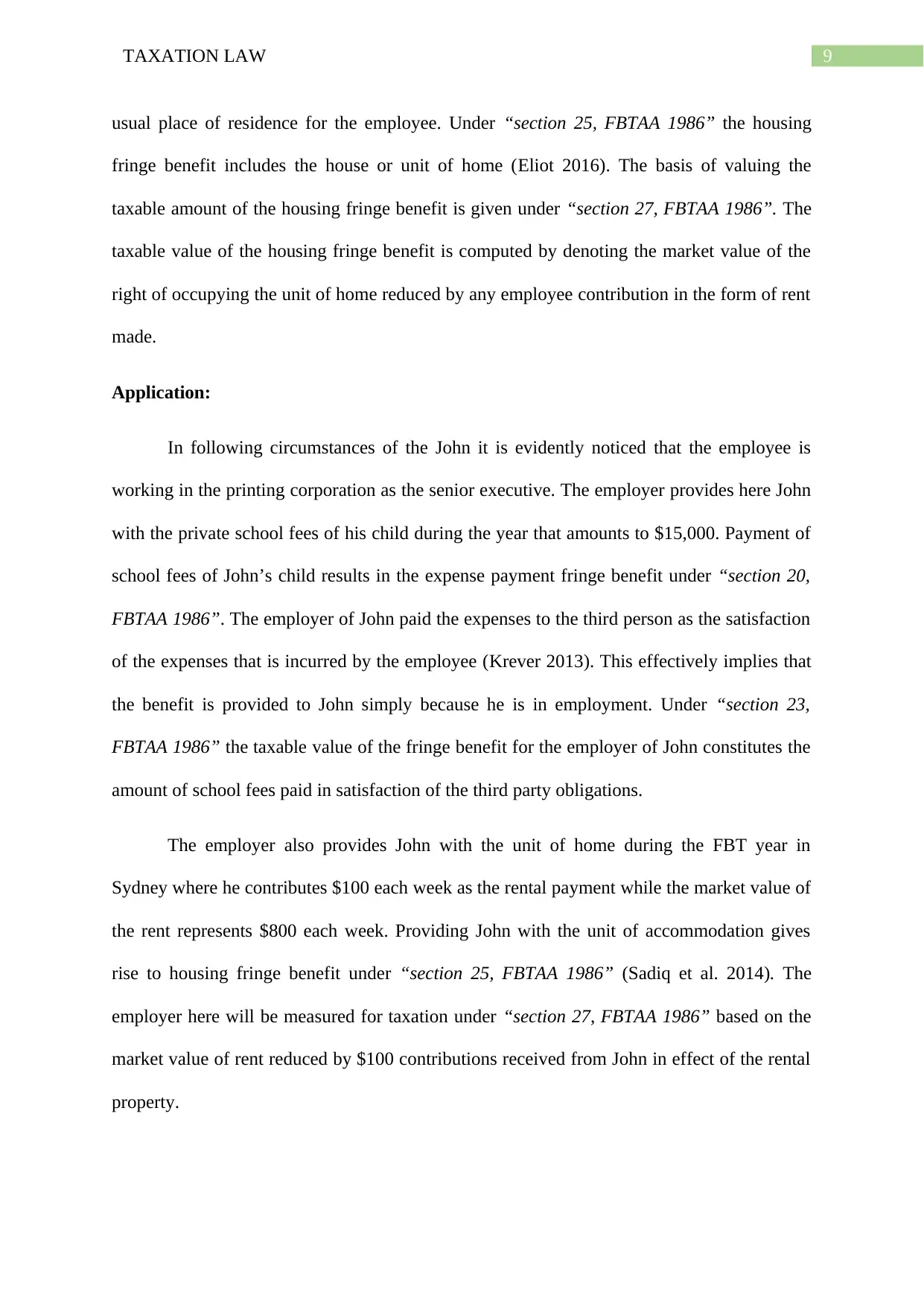
9TAXATION LAW
usual place of residence for the employee. Under “section 25, FBTAA 1986” the housing
fringe benefit includes the house or unit of home (Eliot 2016). The basis of valuing the
taxable amount of the housing fringe benefit is given under “section 27, FBTAA 1986”. The
taxable value of the housing fringe benefit is computed by denoting the market value of the
right of occupying the unit of home reduced by any employee contribution in the form of rent
made.
Application:
In following circumstances of the John it is evidently noticed that the employee is
working in the printing corporation as the senior executive. The employer provides here John
with the private school fees of his child during the year that amounts to $15,000. Payment of
school fees of John’s child results in the expense payment fringe benefit under “section 20,
FBTAA 1986”. The employer of John paid the expenses to the third person as the satisfaction
of the expenses that is incurred by the employee (Krever 2013). This effectively implies that
the benefit is provided to John simply because he is in employment. Under “section 23,
FBTAA 1986” the taxable value of the fringe benefit for the employer of John constitutes the
amount of school fees paid in satisfaction of the third party obligations.
The employer also provides John with the unit of home during the FBT year in
Sydney where he contributes $100 each week as the rental payment while the market value of
the rent represents $800 each week. Providing John with the unit of accommodation gives
rise to housing fringe benefit under “section 25, FBTAA 1986” (Sadiq et al. 2014). The
employer here will be measured for taxation under “section 27, FBTAA 1986” based on the
market value of rent reduced by $100 contributions received from John in effect of the rental
property.
usual place of residence for the employee. Under “section 25, FBTAA 1986” the housing
fringe benefit includes the house or unit of home (Eliot 2016). The basis of valuing the
taxable amount of the housing fringe benefit is given under “section 27, FBTAA 1986”. The
taxable value of the housing fringe benefit is computed by denoting the market value of the
right of occupying the unit of home reduced by any employee contribution in the form of rent
made.
Application:
In following circumstances of the John it is evidently noticed that the employee is
working in the printing corporation as the senior executive. The employer provides here John
with the private school fees of his child during the year that amounts to $15,000. Payment of
school fees of John’s child results in the expense payment fringe benefit under “section 20,
FBTAA 1986”. The employer of John paid the expenses to the third person as the satisfaction
of the expenses that is incurred by the employee (Krever 2013). This effectively implies that
the benefit is provided to John simply because he is in employment. Under “section 23,
FBTAA 1986” the taxable value of the fringe benefit for the employer of John constitutes the
amount of school fees paid in satisfaction of the third party obligations.
The employer also provides John with the unit of home during the FBT year in
Sydney where he contributes $100 each week as the rental payment while the market value of
the rent represents $800 each week. Providing John with the unit of accommodation gives
rise to housing fringe benefit under “section 25, FBTAA 1986” (Sadiq et al. 2014). The
employer here will be measured for taxation under “section 27, FBTAA 1986” based on the
market value of rent reduced by $100 contributions received from John in effect of the rental
property.
Secure Best Marks with AI Grader
Need help grading? Try our AI Grader for instant feedback on your assignments.
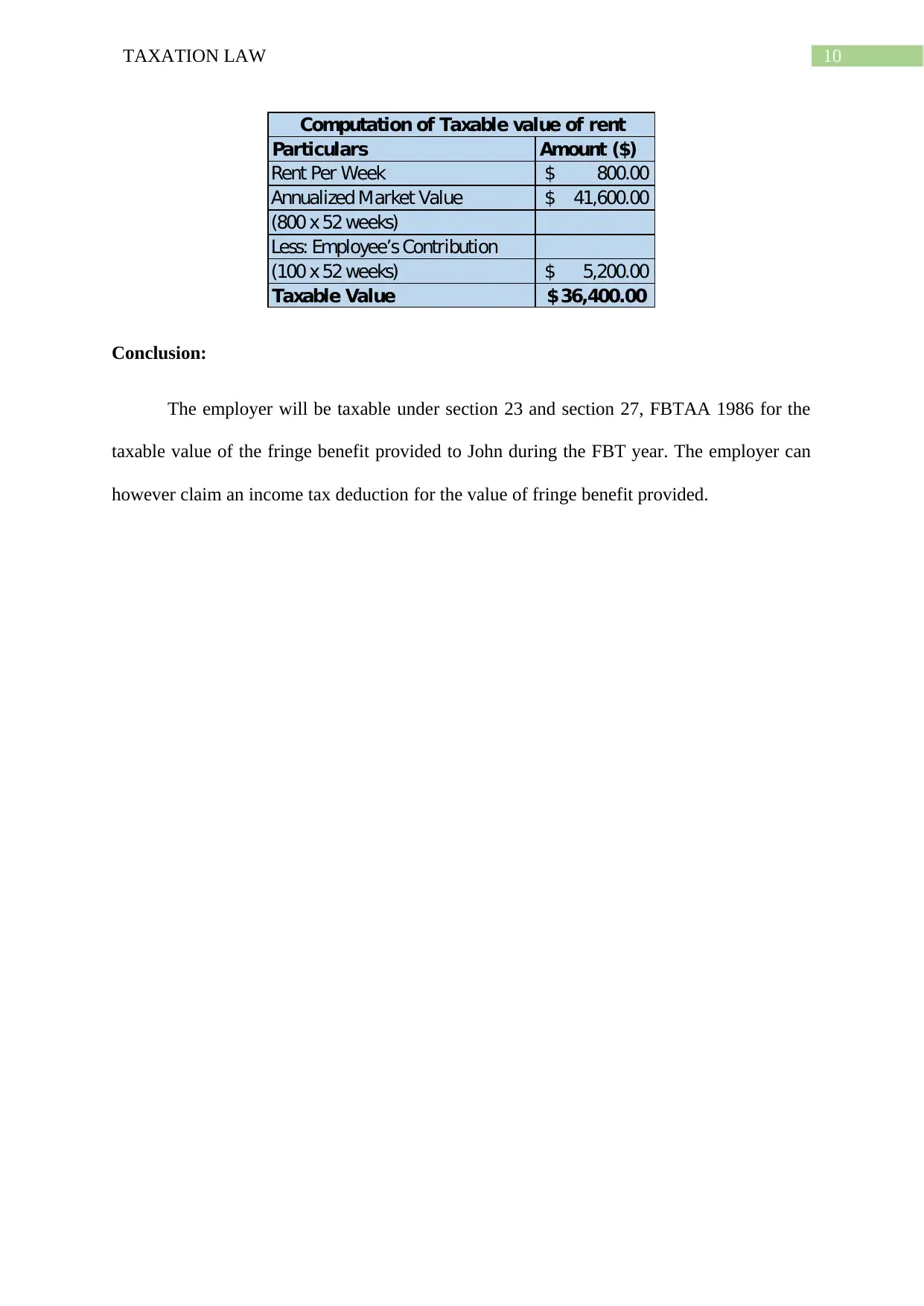
10TAXATION LAW
Particulars Amount ($)
Rent Per Week 800.00$
Annualized Market Value 41,600.00$
(800 x 52 weeks)
Less: Employee’s Contribution
(100 x 52 weeks) 5,200.00$
Taxable Value 36,400.00$
Computation of Taxable value of rent
Conclusion:
The employer will be taxable under section 23 and section 27, FBTAA 1986 for the
taxable value of the fringe benefit provided to John during the FBT year. The employer can
however claim an income tax deduction for the value of fringe benefit provided.
Particulars Amount ($)
Rent Per Week 800.00$
Annualized Market Value 41,600.00$
(800 x 52 weeks)
Less: Employee’s Contribution
(100 x 52 weeks) 5,200.00$
Taxable Value 36,400.00$
Computation of Taxable value of rent
Conclusion:
The employer will be taxable under section 23 and section 27, FBTAA 1986 for the
taxable value of the fringe benefit provided to John during the FBT year. The employer can
however claim an income tax deduction for the value of fringe benefit provided.
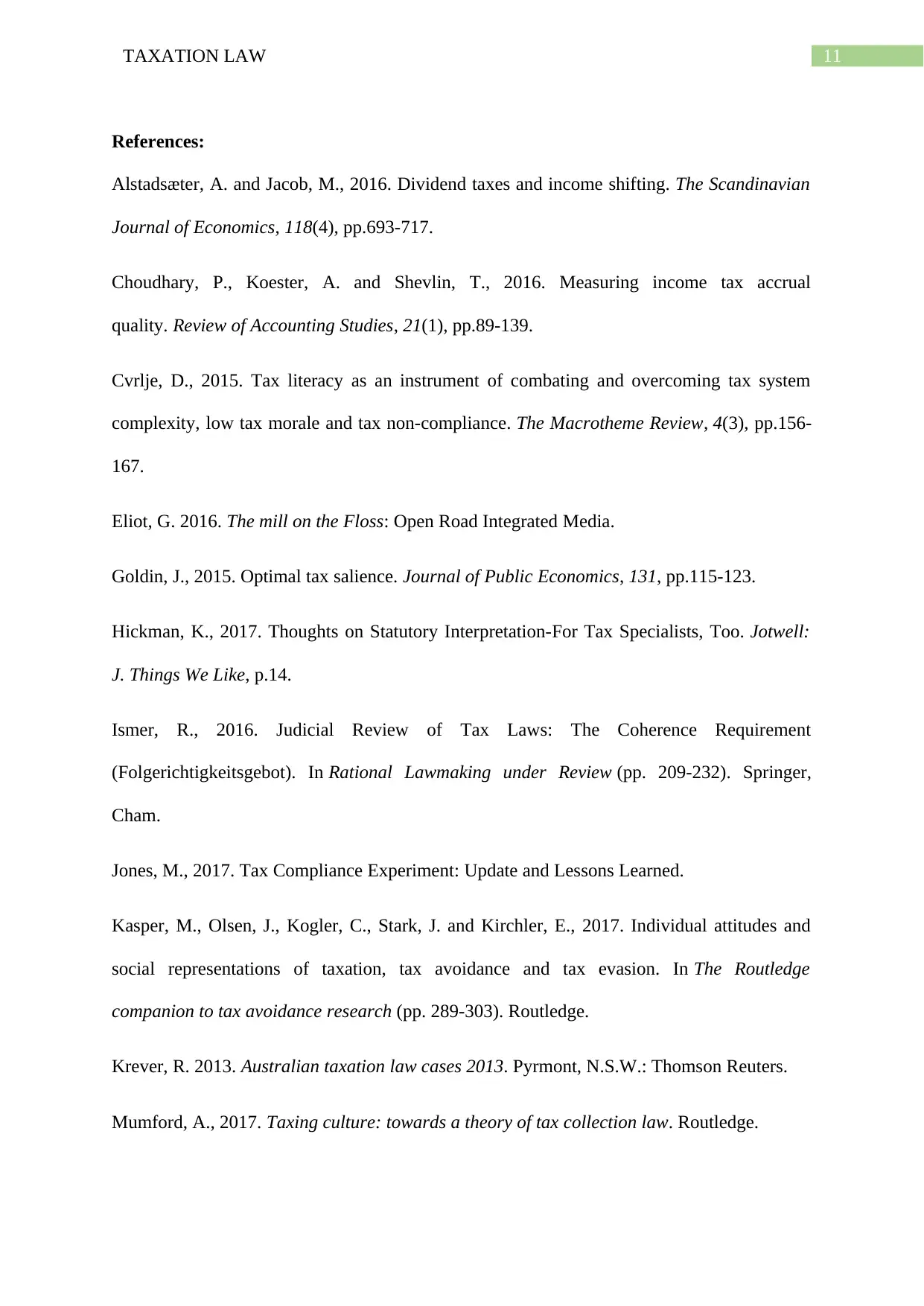
11TAXATION LAW
References:
Alstadsæter, A. and Jacob, M., 2016. Dividend taxes and income shifting. The Scandinavian
Journal of Economics, 118(4), pp.693-717.
Choudhary, P., Koester, A. and Shevlin, T., 2016. Measuring income tax accrual
quality. Review of Accounting Studies, 21(1), pp.89-139.
Cvrlje, D., 2015. Tax literacy as an instrument of combating and overcoming tax system
complexity, low tax morale and tax non-compliance. The Macrotheme Review, 4(3), pp.156-
167.
Eliot, G. 2016. The mill on the Floss: Open Road Integrated Media.
Goldin, J., 2015. Optimal tax salience. Journal of Public Economics, 131, pp.115-123.
Hickman, K., 2017. Thoughts on Statutory Interpretation-For Tax Specialists, Too. Jotwell:
J. Things We Like, p.14.
Ismer, R., 2016. Judicial Review of Tax Laws: The Coherence Requirement
(Folgerichtigkeitsgebot). In Rational Lawmaking under Review (pp. 209-232). Springer,
Cham.
Jones, M., 2017. Tax Compliance Experiment: Update and Lessons Learned.
Kasper, M., Olsen, J., Kogler, C., Stark, J. and Kirchler, E., 2017. Individual attitudes and
social representations of taxation, tax avoidance and tax evasion. In The Routledge
companion to tax avoidance research (pp. 289-303). Routledge.
Krever, R. 2013. Australian taxation law cases 2013. Pyrmont, N.S.W.: Thomson Reuters.
Mumford, A., 2017. Taxing culture: towards a theory of tax collection law. Routledge.
References:
Alstadsæter, A. and Jacob, M., 2016. Dividend taxes and income shifting. The Scandinavian
Journal of Economics, 118(4), pp.693-717.
Choudhary, P., Koester, A. and Shevlin, T., 2016. Measuring income tax accrual
quality. Review of Accounting Studies, 21(1), pp.89-139.
Cvrlje, D., 2015. Tax literacy as an instrument of combating and overcoming tax system
complexity, low tax morale and tax non-compliance. The Macrotheme Review, 4(3), pp.156-
167.
Eliot, G. 2016. The mill on the Floss: Open Road Integrated Media.
Goldin, J., 2015. Optimal tax salience. Journal of Public Economics, 131, pp.115-123.
Hickman, K., 2017. Thoughts on Statutory Interpretation-For Tax Specialists, Too. Jotwell:
J. Things We Like, p.14.
Ismer, R., 2016. Judicial Review of Tax Laws: The Coherence Requirement
(Folgerichtigkeitsgebot). In Rational Lawmaking under Review (pp. 209-232). Springer,
Cham.
Jones, M., 2017. Tax Compliance Experiment: Update and Lessons Learned.
Kasper, M., Olsen, J., Kogler, C., Stark, J. and Kirchler, E., 2017. Individual attitudes and
social representations of taxation, tax avoidance and tax evasion. In The Routledge
companion to tax avoidance research (pp. 289-303). Routledge.
Krever, R. 2013. Australian taxation law cases 2013. Pyrmont, N.S.W.: Thomson Reuters.
Mumford, A., 2017. Taxing culture: towards a theory of tax collection law. Routledge.
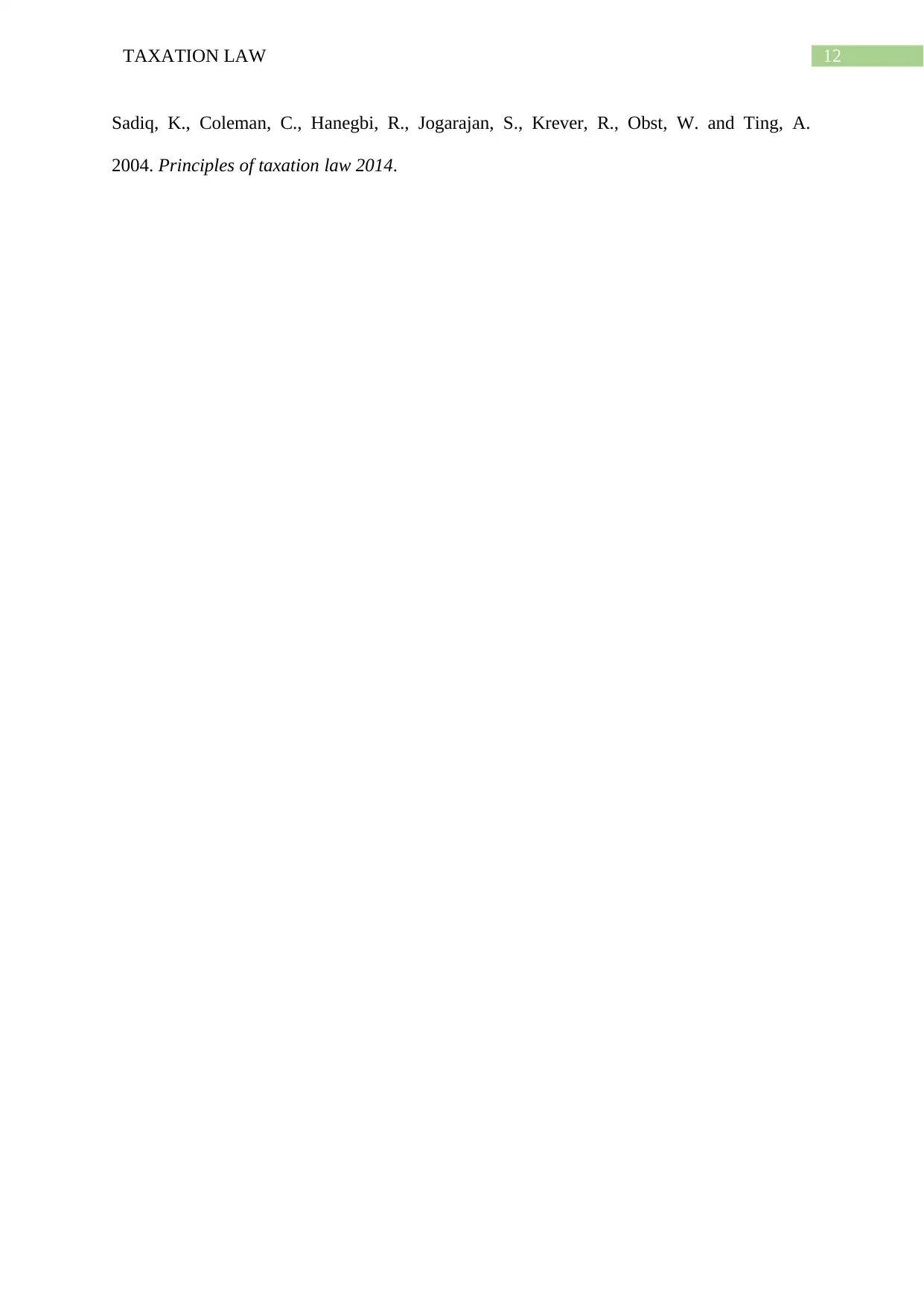
12TAXATION LAW
Sadiq, K., Coleman, C., Hanegbi, R., Jogarajan, S., Krever, R., Obst, W. and Ting, A.
2004. Principles of taxation law 2014.
Sadiq, K., Coleman, C., Hanegbi, R., Jogarajan, S., Krever, R., Obst, W. and Ting, A.
2004. Principles of taxation law 2014.
1 out of 13
Related Documents
Your All-in-One AI-Powered Toolkit for Academic Success.
+13062052269
info@desklib.com
Available 24*7 on WhatsApp / Email
![[object Object]](/_next/static/media/star-bottom.7253800d.svg)
Unlock your academic potential
© 2024 | Zucol Services PVT LTD | All rights reserved.





